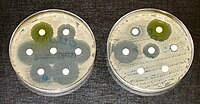
Photo from wikipedia
Infection of multidrug-resistant (MDR) bacteria, such as methicillin-resistant Staphylococcus aureus (MRSA), carbapenem-resistant Enterobacteriaceae (CRE), and extended-spectrum beta-lactamase (ESBL)-producing Escherichia coli, brings public health issues and causes economic burden. Pathogenic bacteria… Click to show full abstract
Infection of multidrug-resistant (MDR) bacteria, such as methicillin-resistant Staphylococcus aureus (MRSA), carbapenem-resistant Enterobacteriaceae (CRE), and extended-spectrum beta-lactamase (ESBL)-producing Escherichia coli, brings public health issues and causes economic burden. Pathogenic bacteria develop several methods to resist antibiotic killing or inhibition, such as mutation of antibiotic function sites, activation of drug efflux pumps, and enzyme-mediated drug degradation. Antibiotic resistance components can be transferred between bacteria by mobile genetic elements including plasmids, transposons, and integrons, as well as bacteriophages. The development of antibiotic resistance limits the treatment options for bacterial infection, especially for MDR bacteria. Therefore, novel or alternative antibacterial agents are urgently needed. Antimicrobial peptides (AMPs) display multiple killing mechanisms against bacterial infections, including directly bactericidal activity and immunomodulatory function, as potential alternatives to antibiotics. In this review, the development of antibiotic resistance, the killing mechanisms of AMPs, and especially, the design, optimization, and delivery of AMPs are reviewed. Strategies such as structural change, amino acid substitution, conjugation with cell-penetration peptide, terminal acetylation and amidation, and encapsulation with nanoparticles will improve the antimicrobial efficacy, reduce toxicity, and accomplish local delivery of AMPs. In addition, clinical trials in AMP studies or applications of AMPs within the last five years were summarized. Overall, AMPs display diverse mechanisms of action against infection of pathogenic bacteria, and future research studies and clinical investigations will accelerate AMP application.
Journal Title: Antibiotics
Year Published: 2022
Link to full text (if available)
Share on Social Media: Sign Up to like & get
recommendations!